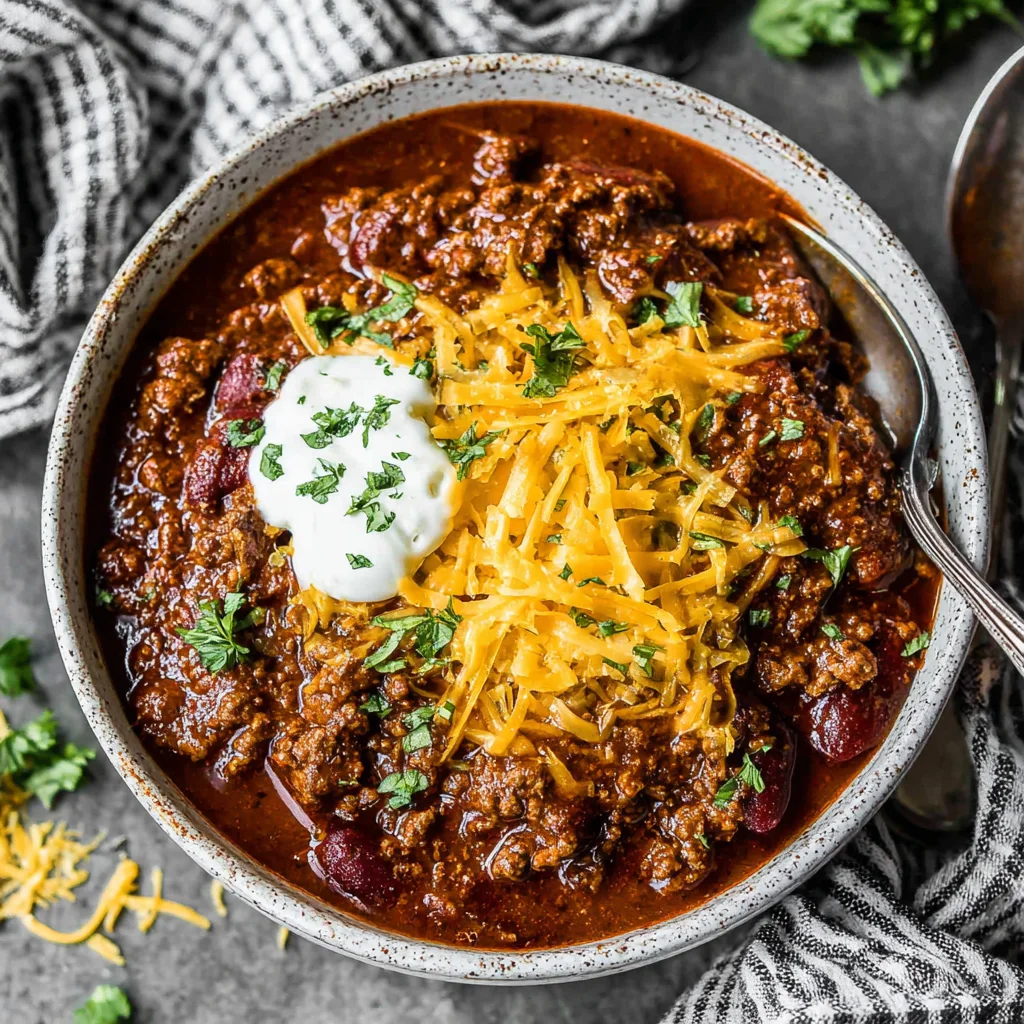Homemade Chili. Just the words conjure up images of a cozy evening, the comforting aroma of simmering spices, and a hearty bowl of deliciousness. This isn’t your average chili; it’s a recipe crafted for flavor depth and ease of preparation, promising a culinary experience that will leave you wanting more. We’re diving deep into the world of chili creation, exploring every nuance from selecting the perfect ingredients to mastering the art of a slow simmer. Forget canned chili – this homemade version is a revelation. It’s the perfect dish for chilly evenings, game day gatherings, or simply a satisfying weeknight meal. Get ready to embark on a flavorful journey with our ultimate guide to creating the best homemade chili you’ve ever tasted.
This recipe isn’t just about throwing ingredients into a pot; it’s about understanding the balance of flavors and the magic of a slow cook. We’ll guide you through each step, ensuring you achieve chili perfection, whether you’re a seasoned chef or a kitchen novice. Prepare yourself for a bowl of warmth and deliciousness that will become a family favorite. And don’t worry, we’ll even cover some amazing variations to personalize your chili experience!
Why You’ll Love This Homemade Chili Recipe
This homemade chili recipe is a game-changer for several reasons. First, it’s incredibly versatile. You can easily adjust the spice level to suit your taste, adding more or less cayenne pepper depending on your preference. The ingredient list is flexible too; feel free to experiment with different beans, meats, or vegetables to create your signature chili. It’s also incredibly flavorful. The long simmering time allows the spices to meld together beautifully, creating a rich and complex taste that elevates this dish above any store-bought option. Beyond the taste, it’s incredibly satisfying. This chili is hearty and filling, perfect for a chilly evening or a weekend gathering. It’s a recipe that will impress your family and friends without requiring hours of difficult cooking techniques.
Moreover, the recipe is surprisingly easy to follow. Even if you’re a beginner in the kitchen, you’ll find the instructions clear and straightforward. The process itself is remarkably simple. You won’t be overwhelmed by complicated techniques or hard-to-find ingredients. Plus, this chili is fantastic for meal prepping. You can easily double the recipe and enjoy delicious chili throughout the week, saving you time and effort in the long run. The leftovers are just as good, if not better, the next day! And finally, it’s a recipe that allows for creative freedom. Experiment with different spices, meats, and beans to personalize your chili and create a unique dish that reflects your culinary preferences.
Why You Should Try This Homemade Chili Recipe
In a world of convenience foods, taking the time to prepare a homemade chili offers a unique and rewarding experience. Beyond the delicious taste, crafting your chili from scratch allows you to control the ingredients, ensuring freshness and quality. You’ll know exactly what’s going into your bowl, which is especially important if you have dietary restrictions or allergies. This recipe empowers you to tailor your chili to your specific needs and preferences, unlike pre-made options that often lack customization. The result is a chili that is deeply satisfying, both in flavor and in the feeling of accomplishment.
Furthermore, making your own chili is surprisingly cost-effective. While the initial ingredient cost might seem higher than buying a can of chili, the yield from this recipe is far greater. You get a substantial amount of chili, enough for multiple meals, making it a budget-friendly option in the long run. This recipe provides a chance to connect with your food on a deeper level. You’re actively participating in the creation of a delicious and nutritious meal, a process that is both therapeutic and fulfilling. You are not just eating; you are experiencing a culinary journey.
Finally, making homemade chili is a wonderful opportunity to impress your friends and family. The rich aroma alone will draw them in, and the taste will leave them craving more. It’s a dish that shows you care, a gesture of love expressed through delicious food. And what could be better than that? If you’re looking to elevate your cooking game, create a meal that is both delicious and fulfilling, and enjoy the rewards of a truly homemade dish, this chili recipe is the perfect starting point. Let’s get cooking!
Ingredients and Necessary Utensils for the Best Homemade Chili
- Meat: 1 pound ground beef (or a mix of beef and turkey for a leaner chili). Consider using grass-fed beef for a richer, more flavorful chili. For a vegetarian alternative, substitute with 1 cup of crumbled vegetarian crumbles or 1 (15-ounce) can of lentils, drained and rinsed.
- Vegetables: 1 large onion, chopped; 2 cloves garlic, minced; 1 green bell pepper, chopped; 1 red bell pepper, chopped. Feel free to add other vegetables like zucchini, carrots, or corn for added texture and nutrients.
- Canned Goods: 1 (28-ounce) can crushed tomatoes; 1 (15-ounce) can tomato sauce; 1 (15-ounce) can kidney beans, rinsed and drained; 1 (15-ounce) can pinto beans, rinsed and drained; 1 (15-ounce) can black beans, rinsed and drained. Choose high-quality canned goods for the best flavor.
- Broth and Spices: 1 cup beef broth (vegetable broth for vegetarian chili); 2 tablespoons chili powder; 1 tablespoon cumin; 1 teaspoon oregano; 1 teaspoon paprika; 1/2 teaspoon cayenne pepper (optional, for extra heat); 1 teaspoon salt; 1/2 teaspoon black pepper. Freshly ground spices always enhance the flavor.
- Oil: 1 tablespoon olive oil. Use a high-quality olive oil for a richer flavor.
- Optional Toppings: shredded cheese (cheddar, Monterey Jack, or your favorite blend), sour cream, chopped onions, avocado. These toppings add a delightful textural and flavorful contrast to the chili.
Recommended Utensils:
- Large Pot or Dutch Oven: A large pot or Dutch oven is essential for making chili. The wide base allows for even cooking, and the deep sides prevent splatter. A 6-quart or larger pot is ideal.
- Cutting Board and Sharp Knife: These are essential for chopping the vegetables. A good cutting board protects your countertop and a sharp knife ensures efficient and safe chopping.
- Wooden Spoon or Spatula: A wooden spoon or spatula is ideal for stirring the chili. Avoid using metal utensils, as they can scratch your pot.
- Measuring Cups and Spoons: Accurate measurements are important for achieving the desired flavor. Use measuring cups and spoons to ensure consistency in your chili.
- Colander: A colander is needed to rinse and drain the beans. Ensure you choose a colander of a suitable size that can accommodate the cans of beans.
- Ladle: A ladle is helpful for serving the chili. A ladle with a generous capacity makes serving easier.
Detailed Recipe Steps for Homemade Chili
- Sauté the Aromatics: Heat the olive oil in a large pot or Dutch oven over medium heat. Add the chopped onion and cook until softened, about 5 minutes. Tip: Don’t rush this step; allowing the onions to soften properly brings out their sweetness and enhances the overall flavor of the chili.
- Add Garlic and Peppers: Add the minced garlic and chopped bell peppers to the pot. Cook for another 3-5 minutes, until slightly tender. Tip: If you’re short on time, you can roughly chop the vegetables instead of mincing them. This will reduce the preparation time but might result in slightly coarser texture.
- Brown the Ground Beef: Add the ground beef to the pot and cook, breaking it up with a spoon, until browned. Drain off any excess grease. Essential Tip: Make sure the beef is fully browned to prevent a raw meat taste. Drain off the excess grease to reduce the fat content and create a cleaner chili flavor.
- Combine Ingredients: Stir in the crushed tomatoes, tomato sauce, kidney beans, pinto beans, black beans, beef broth, chili powder, cumin, oregano, paprika, cayenne pepper (if using), salt, and pepper. Tip: Ensure that all ingredients are well combined for even cooking and flavor distribution.
- Simmer the Chili: Bring the chili to a simmer, then reduce heat to low, cover, and cook for at least 1 hour, or longer for a richer flavor. The longer it simmers, the better it tastes! Stir occasionally. Essential Tip: Low and slow is key to developing deep flavors. Simmering for at least an hour allows the spices to meld and the chili to thicken.
- Adjust Seasoning: Taste and adjust seasonings as needed. You may want to add more chili powder, cumin, salt, or pepper depending on your preference. Tip: Taste the chili at the beginning and end of the cooking process. Your taste buds will adapt to the flavors. If necessary, adjust seasoning accordingly.
- Serve Hot: Serve the chili hot, topped with your favorite chili toppings. Enjoy! Tip: Allow the chili to rest for 10-15 minutes before serving. This allows the flavors to settle and intensifies the taste. Serve with a dollop of sour cream, shredded cheese, and chopped onions for an extra punch of flavor and texture.
Tips and Variations for Your Homemade Chili
This recipe is your starting point; feel free to experiment and make it your own! For a spicier chili, add more cayenne pepper or a pinch of chipotle powder. To make it milder, omit the cayenne pepper altogether. If you prefer a thicker chili, simmer it uncovered for the last 15-20 minutes to reduce the liquid. For a vegetarian chili, substitute the ground beef with 1 cup of lentils or 1 cup of your favorite vegetarian crumbles. Remember to use vegetable broth instead of beef broth.
You can also experiment with different types of beans. Try using black-eyed peas, Great Northern beans, or a combination of several types. Add different vegetables like corn, zucchini, or mushrooms for added texture and flavor. To enhance the flavor profile, try adding a tablespoon of dark chocolate or a splash of Worcestershire sauce during the last 15 minutes of cooking. A touch of smoky flavor can be added using chipotle peppers in adobo sauce. Simply add a tablespoon of the sauce along with the other spices for a southwestern twist.
To avoid common mistakes, be sure to properly brown the meat to prevent any raw taste. Don’t overcook the vegetables; they should be tender-crisp, not mushy. And remember that the flavor of the chili develops over time, so the longer it simmers, the better it will taste. Finally, don’t be afraid to adjust the seasoning to your own taste preferences. It’s your chili; make it your own!
Nutritional Values and Health Benefits of Homemade Chili
While the exact nutritional values will vary depending on the specific ingredients used, homemade chili is generally a nutritious and balanced meal. It’s a good source of protein, thanks to the ground beef or vegetarian alternative, and fiber, from the beans and vegetables. Beans are particularly beneficial, offering a range of nutrients, including iron, folate, potassium, and various antioxidants. They are also a great source of plant-based protein and fiber, which contribute to satiety and digestive health.
The vegetables in this chili, such as onions and bell peppers, add essential vitamins and minerals, like vitamin C and vitamin A. Tomatoes, rich in lycopene, contribute to this recipe’s antioxidant power. Lycopene is an antioxidant that has been linked to a reduced risk of heart disease and certain types of cancer. Chili powder and cumin, key spices in this recipe, have their own potential health benefits. Chili powder can help to boost your metabolism, while cumin can aid digestion and reduce inflammation.
It’s important to note that the nutritional value can be significantly impacted by the type of meat used. Lean ground beef or turkey is preferable to reduce saturated fat intake. Choosing low-sodium canned goods can also help control sodium levels. The nutritional information provided below is approximate and is only for general guidance. For precise nutritional data tailored to your specific recipe, we strongly recommend using a nutrition calculator to accurately measure the calories, protein, carbohydrates, and fats. The information given here should not substitute for personalized advice from a registered dietitian or nutritionist.
FAQs
How long can I store leftover Homemade Chili?
Can I freeze Homemade Chili?
What are some good substitutions for ground beef in Homemade Chili?
How can I make my Homemade Chili spicier?
Is this Homemade Chili recipe gluten-free?
This Homemade Chili recipe is a guaranteed crowd-pleaser. From its comforting aroma to its rich, satisfying taste, it’s a dish that will warm your heart and soul. We hope you’ve enjoyed this detailed guide and found inspiration to create your own culinary masterpiece. Don’t forget to share your chili creations with us in the comments below! And for more delicious recipe ideas, check out our other posts, like this amazing 3-ingredient dip perfect for game day, or these fluffy pumpkin pancakes for a delightful autumn treat. Happy cooking, and remember to share your culinary journey with us! You can also pin this recipe to your Pinterest board for later – check out our Pinterest page for more inspiration!



